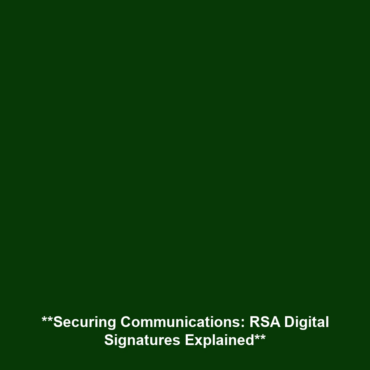Symmetric-Key Cryptography: The Same Key is Used for Both Encryption and Decryption
Introduction
Symmetric-Key Cryptography is a fundamental aspect of Cryptography that plays a pivotal role in securing data transmission across various platforms. It involves the use of a single key for both encryption and decryption processes, emphasizing the importance of key management in maintaining confidentiality. The significance of symmetric-key methods extends across numerous applications, from securing online communications to protecting confidential information in financial transactions. As cyber threats grow increasingly sophisticated, understanding the mechanics and implications of symmetric-key cryptography is vital for individuals and organizations striving for robust cybersecurity.
Key Concepts
What is Symmetric-Key Cryptography?
In symmetric-key cryptography, both the sender and recipient utilize the same cryptographic key to encrypt and decrypt messages. The process is efficient, as it involves less computational power compared to asymmetric cryptography. However, the challenge lies in securely sharing and managing this key to prevent unauthorized access.
Principles of Symmetric-Key Cryptography
- Encryption and Decryption: The encryption process transforms plaintext into ciphertext using the same key for reverse conversion.
- Key Management: Effective key management practices are essential to enhance security and facilitate safe key exchanges.
- Algorithm Types: Popular symmetric-key algorithms include AES (Advanced Encryption Standard), DES (Data Encryption Standard), and RC4.
Applications and Real-World Uses
The applications of Symmetric-Key Cryptography are vast and diverse, demonstrating its significance in real-world scenarios:
- Secure Communication: Commonly used in messaging platforms to ensure private conversations remain confidential.
- Data Encryption: Protects sensitive data stored on devices and databases from unauthorized access.
- Network Security: Protocols such as IPsec and SSL/TLS utilize symmetric-key cryptography to safeguard data in transit.
Current Challenges
Despite its effectiveness, Symmetric-Key Cryptography faces several challenges that impact its application within the Cryptography landscape:
- Key Distribution: Securely sharing cryptographic keys between parties remains a significant obstacle.
- Scalability: As the number of users increases, the requirement for unique keys for effective encryption becomes cumbersome.
- Vulnerability to Attacks: As computational power increases, symmetric-key algorithms may become susceptible to brute-force attacks.
Future Research and Innovations
The future of Symmetric-Key Cryptography is poised for advancements driven by emerging technologies. Innovations in quantum cryptography may enhance key distribution methods, offering solutions to current challenges. Research efforts are also focused on developing more robust algorithms that withstand advanced cyber attacks, ensuring data security in an ever-evolving digital landscape.
Conclusion
In summary, Symmetric-Key Cryptography is an essential component of Cryptography, utilizing a single key for both encryption and decryption. Understanding its principles, applications, challenges, and future directions is crucial for anyone interested in the field of cybersecurity. For more insights, explore our articles on advanced cryptography techniques and latest cybersecurity trends.


